Sri Harmandir Sahib, also known as Sri Darbar Sahib or Golden Temple, (on account of its scenic beauty and golden coating for English speaking world), is named after Hari(God) the temple of God. The Sikhs all over the world, daily wish to pay visit to Sri Amritsar and to pay obeisance at Sri Harmandir Sahib in their Ardas.
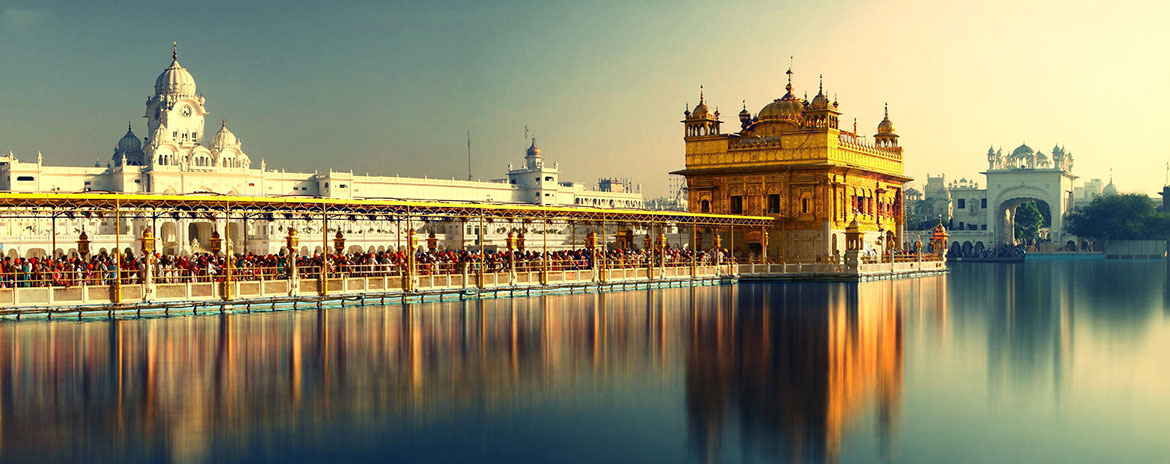
Sri Darbar Sahib, Sri Amritsar
-
Hisroty Of Golden Temple
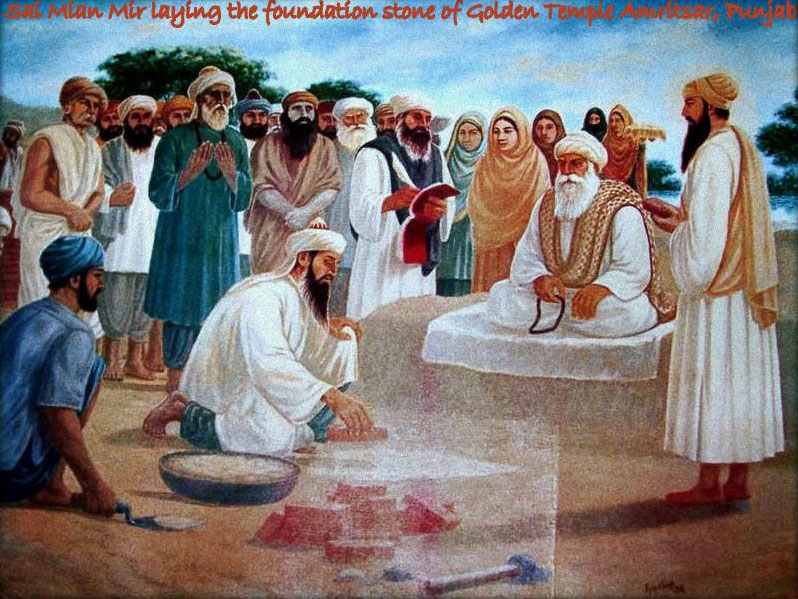
The Sri Harmandir Sahib was invaded and destroyed many a times by the Afghan and other invaders. Each and every time the Sikhs had to sacrifice their lives in order to liberate it and restore its sanctity. After the martyrdom of Bhai Mani Singh ji in 1737, Massa Ranghar, the Kotwal of Amritsar took charge of Sri Harmandir Sahib in 1740 and converted it into a civil court and began to hold notch parties. This act created great resentment among the Sikhs. Two warriors, Sukha Singh and Mahtab Singh avenged the insult by a dare devil act.
They entered the temple complex in guise of peasants, severed the head of Massa Ranghar with a single blow of kirpan and fled away with decapitated head on one of the their spearsAfter this incident the security around the Sri Harmandir Sahib was further tightened and the temple was locked. Now, it was the turn of Lakhpat Rai, a Hindu Diwan of Lahore Darbar as he vowed to finish the entire Sikh Nation. In order to avenge the death of his brother Jaspat Rai, he befouled the Sarovar and desecrated Sri Harmandir Sahib in 1746.
He even banned the name ‘Guru’. The Mughal forces marched against the Sikhs under the command of Diwan Lakhpat Rai and Yahiya Khan. A fierce battle was fought( the first Ghalughara in june 1746) in which nearly seven thousand Sikhs were martyred. Three thousand of them were put to death publicly at Lahore, (the site is now called Shaheedganj).
After this hollowcast, the Sikhs under the efficient leadership of Sardar Jassa Singh Ahluwalia retaliated back and recaptured both the city and Sri Harmandir Sahib killing Salabat Khan in March, 1748. They celebrated Vaiskhi with great enthusiasm by clearing the holy Sarovar and restoring the daily Maryada at Sri Harmandir Sahib. They also held ‘Sarbat Khalsa’. The Dewali festival of 1748 was also celebrated enthusiastically.
In 1757, Ahmad Shah Abdali invaded India for the second time and attacked Amritsar. He demolished Sri Harmandir Sahib and filled the Sarovar (tank) with garbage. On hearing of the desecration, Baba deep Singh ji Saheed, the head of ‘Misl Shaheedan’, started at once to avenge the insult. A bloody encounter took place at the village Gohalwar near Amritsar. Baba Deep Singh was mortally wounded. He gripped and supported his severed head with his left hand and with the right, he went on mowing down the enemies. Thus fighting, this unique warrior reached the holy precincts and laid down his life for the cause of maintaining sanctity of Sri Harmandir Sahib.
On 10th April, 1762, Ahmed Shah Abdali again invaded Amritsar and Sri Harmandir Sahib, after the horrible carnage of the Sikhs at Kup Harira. On this occasion thousands of armed and unarmed Sikhs had gathered at the temple for a holy bath. Countless Sikhs laid down their lives in defense of their beloved shrine. Sri Harmandir Sahib was again blown up with gun powder and the holy tank was also desecrated. It is said that while the building of the shrine was being blown up, a flying brick bat struck the Shah on the nose. This wound proved fatal for him.
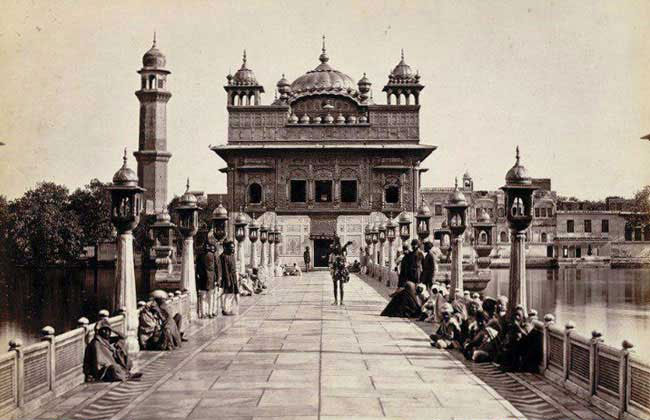
In December, 1764, Sri Harmandir Sahib was again attacked by Ahmed Shah Abdali with the sole object of destroying the entire Sikh Nation. But before his arrival the Sikhs abandoned the city and to his surprise he found only thirty Sikhs in the vicinity of Sri Harmandir Sahib, who under the command of Baba Gurbax Singh ji gave him stiff resistance and all were martyred. Abdali, again pulled down the newly constructed structure of the Shrine and leveled the holy tank.
Before the final departure from India in 1767, Ahmed Shah Abdali again attacked Amrtisar but he dared not enter Sri Harmandir Sahib, and it remained under the control of the Sikhs ever afterwards. (In June, 1984 it was attacked by the Indian Army, under operation Blue Star in which several hundred innocent Sikh pilgrims were killed).
After the Martydom of Bhai Mani Singh ji Sri Harmandir Sahib was collectively managed by the Sikh misls and many Bungas( Mansions) were constructed. Whenever the Sikh leaders visit Amritsar, they did not interfere in the affairs of the temple. All the general gatherings were held on Akal Takhat Sahib only in the presence of Guru Granth Sahib. During the rule of Maharaja Ranjit Singh the administration of Sri Harmandir Sahib went under the control of the State. Maharaja took keen interest in the development and beautification of Sri Harmandir Sahib.
During the British period, Sri Harmandir Sahib passed under the control of one man the ‘Sarbrah’ (Manager), a nominee of Deputy Commissioner of Amritsar. The Deputy commissioner of Amritsar also made a committee of so-called sikh Sardars and Raises. The Pujaries, Mahants, Ragis and other functionaries began to receive their customary share of offerings at the Temple. On the other hand immoral acts were practiced by them within the precincts of the temple with the connivance of Sarbrah. Great resentment prevailed among the Sikhs and outcome of this was Sikh Gurdwara Reform Movement. Now again the Sikhs had to sacrifice their lives for the cause of Sri Harmandir Sahib and other Shrines. The Shiromani Akali Dal became the spear head of the struggle for the reform of the places of worship.
The curtain was finally rung down upon the Gurdwara Reform Movement, when the Sikh Gurdwara Act, 1925, vested the control and management of Sri Harmandir Sahib in the Shiromani Gurdwara Parbandhak Committee, a representative body of the Sikhs elected by adult franchise.
Foundation Of Golden Temple
Sri Harmandir Sahib, also known as Sri Darbar Sahib or Golden Temple, (on account of its scenic beauty and golden coating for English speaking world), is named after Hari(God) the temple of God. The Sikhs all over the world, daily wish to pay visit to Sri Amritsar and to pay obeisance at Sri Harmandir Sahib in their Ardas.Guru Arjan Sahib, the Fifth Nanak,conceived
the idea of creating a central place of worship for the Sikhs and he himself designed the architecture of Sri Harmandir Sahib. Earlier the planning to excavate the holy tank (Amritsar or Amrit Sarovar ) was chalked out by Guru Amardas Sahib, the Third Nanak, but it was executed by Guru Ramdas Sahib under the supervision of Baba Budha ji. The land for the site was acquired by the earlier Guru Sahibs on payment or free of cost from the Zamindars (landlords) of native villages. The plan to establish a town settlement was also made. Therefore, the construction work on the Sarovar(the tank) and the town started simultaneously in 1570. The work on both projects completed in 1577 A.D.
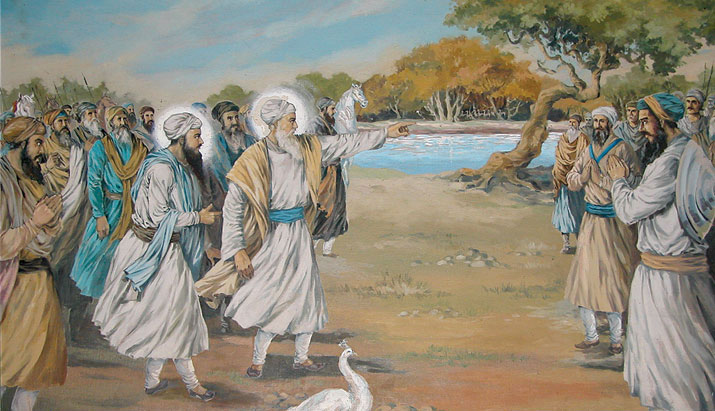
Guru Arjan Sahib got its foundation laid by a muslim saint Hazrat Mian Mir ji of Lahore on 1st of Magh, 1644 Bikrmi Samvat(December,1588). The construction work was directly supervised by Guru Arjan Sahib himself and he was assisted by the prominent Sikh personalities like Baba Budha ji, Bhai Gurdas ji, Bhai Sahlo ji and many other devoted Sikhs.
Unlike erecting the structure on the higher level(a tradition in Hindu Temple architecture), Guru Arjan Sahib got it built on the lower level and unlike Hindu Temples having only one gate for the entrance and exit, Guru Sahib got it open from four sides. Thus he created a symbol of new faith, Sikhism. Guru Sahib made it accessible to every person without any distinction of Caste, creed, sex and religion.
The building work completed in 1601 A.D. on Bhadoon Sudi 1st, 1661 Bikrmi Samvat (August/September,1604). Guru Arjan Sahib installed newly created Guru Granth Sahib, in Sri Harmandir Sahib and appointed Baba Budha ji as its first Granthi i.e. the reader of Guru Granth Sahib. After this event it attained the status of Ath Sath Tirath. Now the Sikh Nation had their own Tirath, a pilgrimage center.
Sri Harmandir Sahib, is built on a 67ft. square platform in the centre of the Sarovar(tank). The temple itself is 40.5ft. square. It has a door each on the East, West, North and South. The Darshani Deori (an arch) stands at the shore end of the causeway. The door frame of the arch is about 10ft in height and 8ft 6inches in breath. The door panes are decorated with artistic style. It opens on to the causeway or bridge that leads to the main building of Sri Harmandir Sahib. It is 202 feet in length and 21 feet in width.
The bridge is connected with the 13 feet wide “Pardakshna” (circumambulatory path). It runs round the main shrine and it leads to the “Har ki Paure” (steps of God). On the first floor of “Har ki Paure”, there is continuous reading of Guru Granth Sahib.
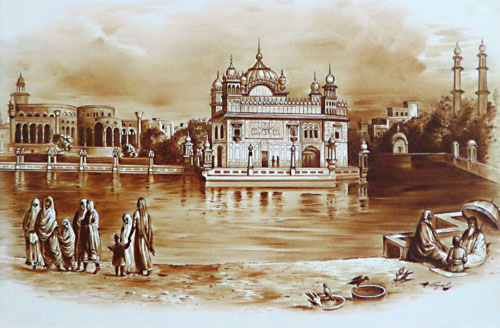
The main structure of Sri Harmandir Sahib, functionally as well as technically is a three-storied one. The front, which faces the bridge, is decorated with repeated cusped arches and the roof of the first floor is at the height of the 26 feet and 9 inches.
At the top of the first floor 4 feet high parapet rises on all the sides which has also four Mamtees on the four corners and exactly on the top of the central hall of the main sanctuary rises the third story. It is a small square room and have three gates. A regular recitation of Guru Granth Sahib is also held there.
On the top of this room stands the low fluted “Gumbaz”(dome) having lotus petal motif in relief at the base inverted lotus at the top which supports the “Kalash” having a beautiful “Chhatri” at the end.
Its architecture represents a unique harmony between the Muslims and the Hindus way of construction work and this is considered the best architectural specimens of the world. It is often quoted that this architecture has created an independent Sikh school of architecture in the history of art in India.
-
Around the Golden Temple
Golden Temple includes the number of anothers Gurudwara’s,Rest Houses,Langar Hall,Central Sikh Meseum,Offices etc. A visit to the Golden Temple is incomplete without a visit to the following among others-
- AKAL TAKHAT
- BABA ATAL
- GURU KA LANGAR
- SRI GURU RAM DAS NIWAS
- GURU NANAK NIWAS
- AKAL REST HOUSE
- GURU HARGOBIND NIWAS
Akal Takhat Sahib:
It rightly faces the Golden Temple. Built by the Sixth Master Guru Hargobind (1606-44) in 1609, has been the nerve centre or the Sikhism ever since. All commandments affecting the community as a whole were and are issued from here. The Akal Takhat was used for holding court and Sikh congregations in the days of its builder. The Akal Takhat was pulled down several times by the Muslim raiders. The ground floor of the present building was constructed in 1 874. Three storeys were subsequently added by Maharaja Ranjit Singh. A number of weapons used by Guru Hargobind, Guru Gobind Singh and other Sikh heroes are preserved at Akal Takhat. In 1984 during Operation Blue Star Akal Takhat was badly damaged by the Indian Army.
Baba Atal Ji:
A nine-storeyed tower, built in memory of Atal Rai (D. 1628), a son of Hargobind, is called Baba Atal. Atal Rai died at nine. He was called ‘Baba’ (an old man) head over young shulders. The tower was built between 1778 and 1784. It is the only of its kind in the city with 108 ft. height.
Guru Ka Langar:A Sikh temple without a Community Kitchen is inconceivable. Cooked food is serviced in the kitchen of the Golden Temple 24 hours to all visitors irrespective of religion, caste, creed and nationality. The expenses are met out of the Temple funds. Approximately 40,000 visitors share the meals everyday presently.
Sri Guru Ramdas Niwas:
The Niwas is a free hostel for the pilgrims maintained by the Temple authorities. It has been built by the Gurdwara Committee. It has 228 rooms and 18 big halls. Unlike the ordinary ‘Daramsalas’ the Niwas supplies the facilities of free beddings, cots, lights and fans etc. to the lodgers. A lodger is not generally allowed to stay here for more than three days at a time. The doors of the hostels are open to all. The lodgers however must not do anything repugnant to the teachings of Sikhism.
Guru Nanak Niwas:
There are 66 Rooms in Guru Nanak Niwas-22 with attached baths and 4-4 without baths, but on each floor there are 10 bath rooms and fen flush latrines so as to make stay comfortable.
Akal Rest House:
There is Akal Rest House having 26 rooms with double beds and attached bath rooms are provided on a nominal Rent.
Guru HarGobind Niwas:
There are 92 double bed rooms with attached bath in addition to four halls. Rooms are available at Rs. 50/- per day.
